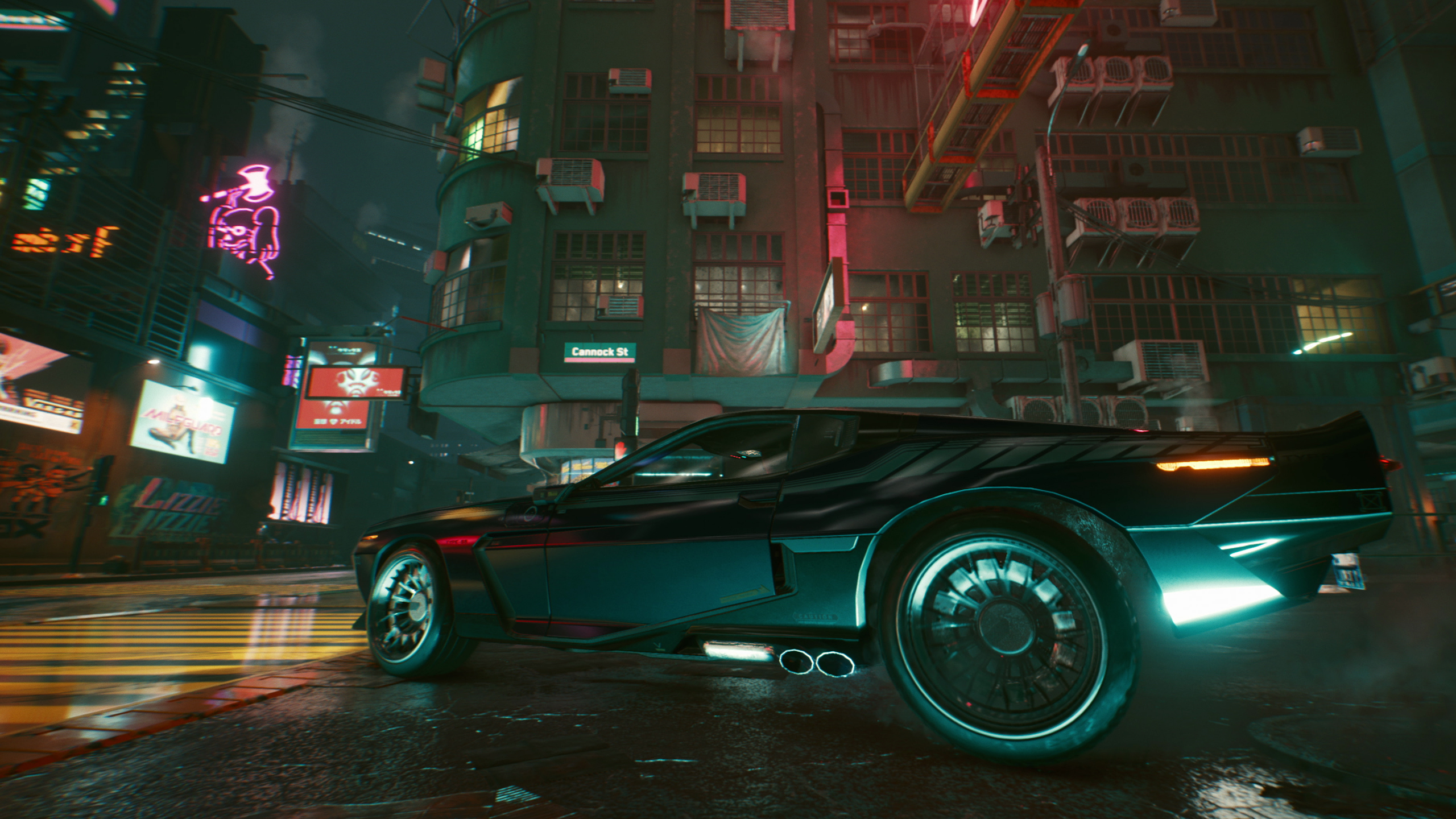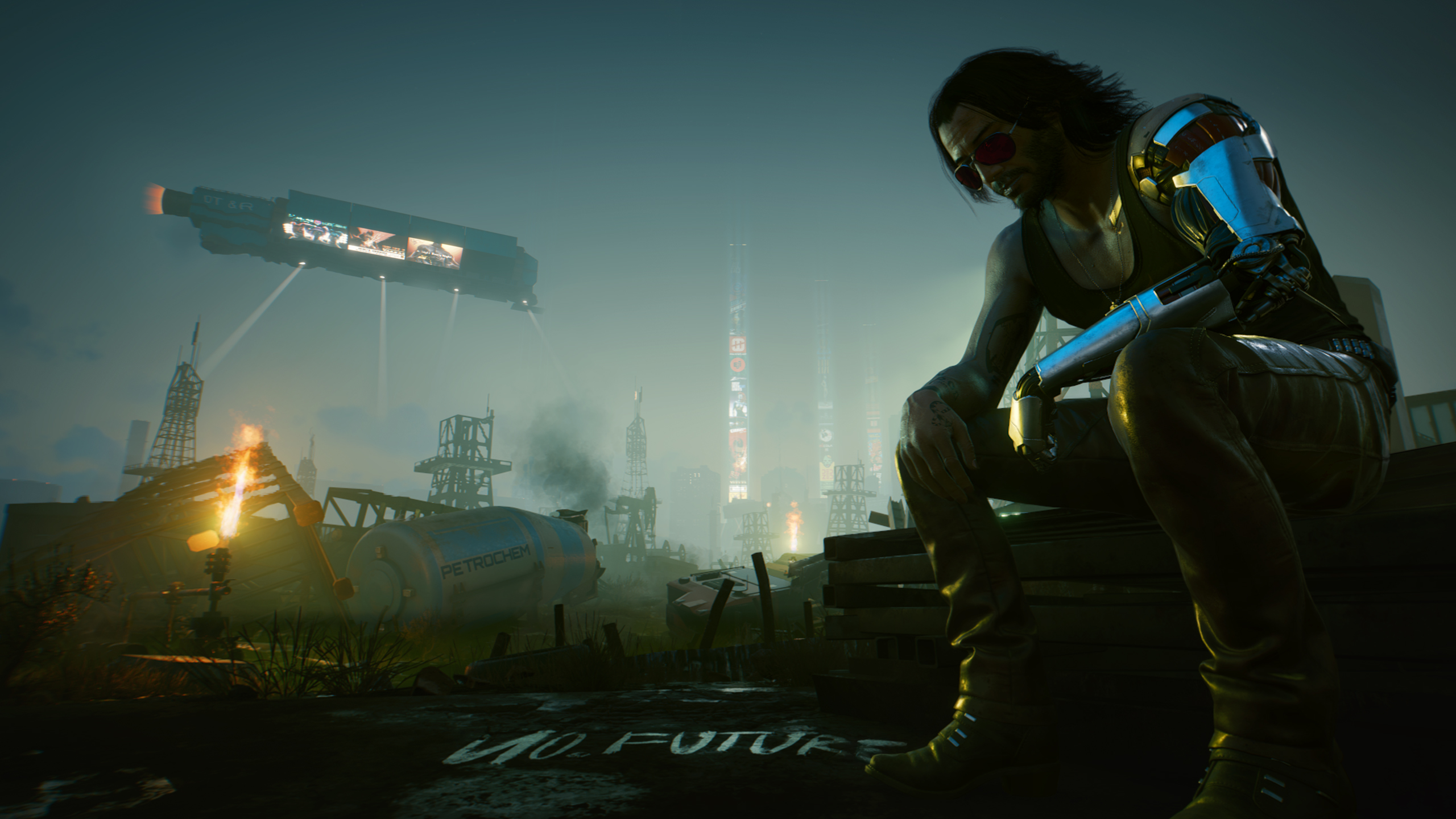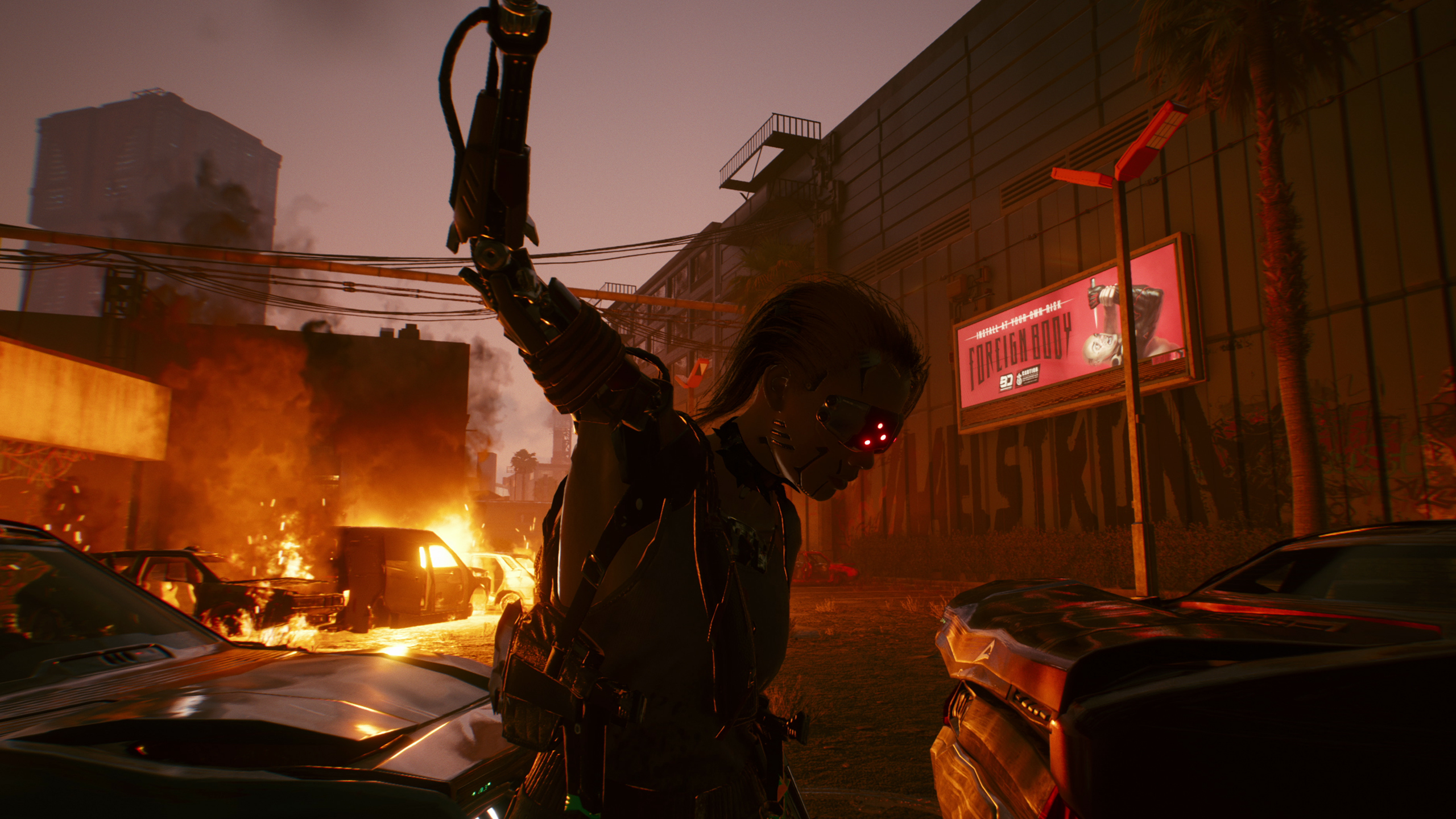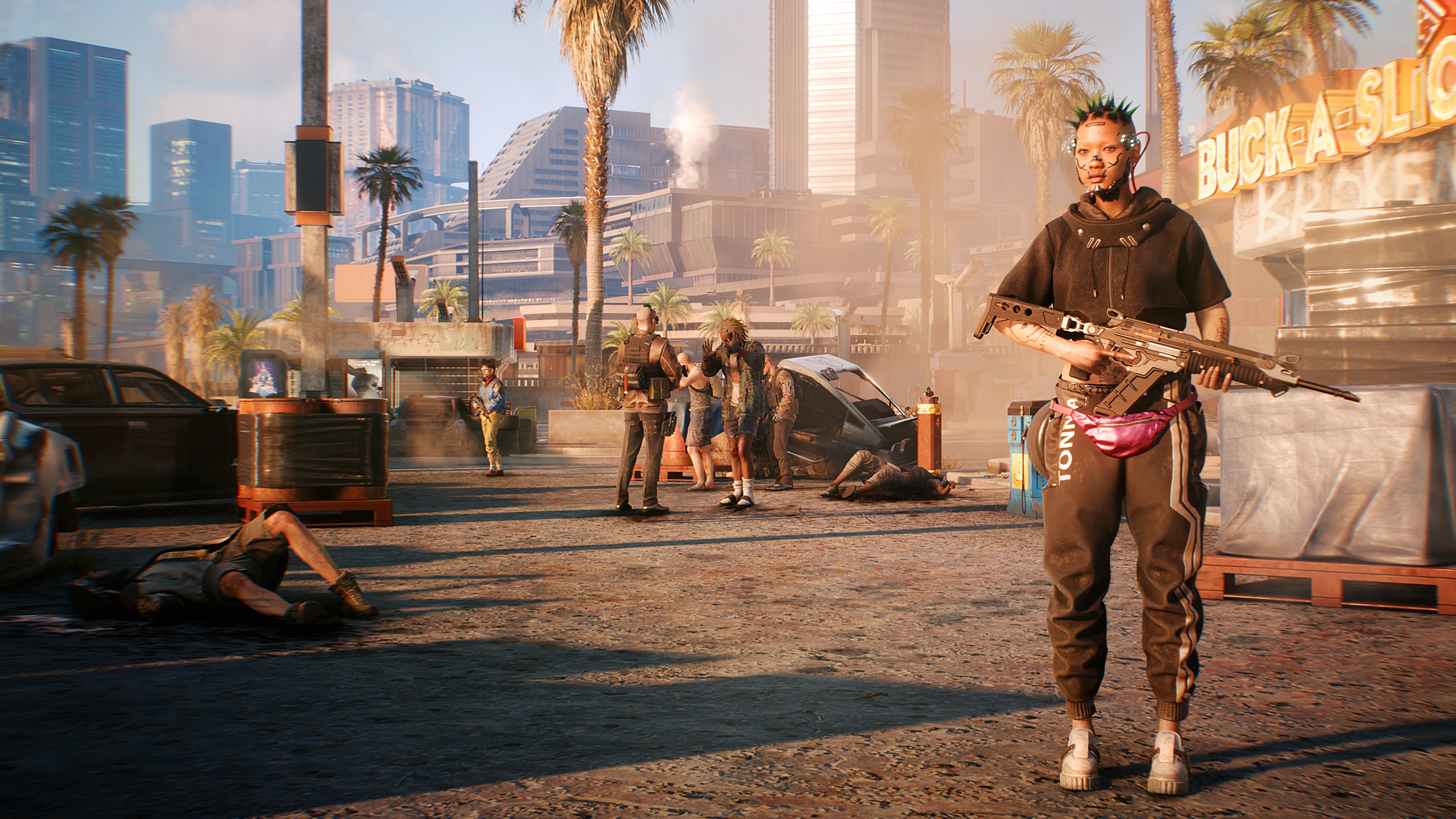I love being a cyber samurai, and other revelations from playing 15 hours of Cyberpunk 2077
Impressions from our longest hands-on yet.

A few months ago I played Cyberpunk 2077 for 4 hours, and wrote that I was hungry for more. Now, after another 15 hours with the year's most anticipated game, I'm positively ravenous. In my demo, which was spread out across two days and started at the very beginning of the game, I drifted between big, important story missions and weird, tiny side quests—and did a lot of other fun, interesting stuff along the way. This is the biggest chunk of the game I've played so far, but I've still only lightly scratched its shiny chrome surface.
I did Akira slides on motorcycles, hacked peoples' brains, stole more cool-looking futuristic cars than I can count, and ate synthmeat yakitori. I met dozens of eccentric characters, played factions against each other, drove beyond the city walls into the desert, made a few powerful enemies, and hung out with Keanu Reeves. A few things didn't quite land for me (more on that later), but after all this my desire to play the finished game is more powerful than ever.

About seven hours into my hands-on, I found the Black Unicorn. Until that point I'd mostly been using handguns to deal with Night City's cyber-limbed gangsters and sharp-suited corporate goons. I used a nice rapid-fire one in chrome with pink accents. But now I had a katana—and a lethally sharp one at that. Then when I realised I could silently take out entire squads of gun-toting bad guys with it, shooting people with guns suddenly felt very pedestrian.
Cyberpunk 2077's loot system categorises the Black Unicorn as a Legendary weapon, the highest tier. It's also a reference to a sword from The Witcher, and its tongue-in-cheek description claims it was 'forged DRM-free, which makes it extra light and nimble. Dealing 700 damage per second, and with an increased chance of causing bleeding and scoring critical hits, it's obscenely powerful—and only became more deadly as I unlocked a selection of blade-focused perks.
Swords aren't just melee weapons you fall back on when you're out of ammo
Swords in Cyberpunk 2077 aren't just melee weapons you fall back on when you're out of ammo. They can be that, but they can also be an entire play style. Sword-specific perks include Slow and Steady, which increases your armour as you sprint, letting you close in on enemies without being shot to pieces. And Deathbolt (the icon for which shows V licking a katana) restores your health and increases your movement speed at the moment you kill someone with any bladed weapon.
A quality sword like the Black Unicorn, combined with these perks, makes wielding a blade in Cyberpunk 2077 incredibly satisfying and super effective. If you're careful, and use the environment to your advantage, you can clear out an entire facility of heavily armed soldiers without firing a shot. Throw hacking into the mix, disabling security cameras and rebooting optical implants to temporarily blind enemies, and you end up with more compelling reasons to keep your gun holstered and your sword unsheathed.

Of course, this is just one of countless ways to play Cyberpunk 2077. This is a deep RPG, and through perks, gear, and increasing your stats when you level up, you can tailor your V's build to fit around how you want to interact with Night City. If you prefer to shoot your way out of trouble, there's a whole suite of perks dedicated to that too. But while the shooting is great—the guns feel nicely weighty and powerful—once I'd sliced my way through a group of oblivious Maelstrom scavs with the Black Unicorn, it was swords all the way for me.
Keep up to date with the most important stories and the best deals, as picked by the PC Gamer team.
This open-ended design extends to almost every aspect of Cyberpunk 2077, including its missions. This was most evident in a job I picked up early on, which involves sneaking into a massive warehouse, infecting a computer system with a virus, and (if all goes to plan) escaping unseen. The building belongs to Arasaka, Night City's most powerful megacorporation, so no expense has been spared when it comes to security. There are guards, mechs, cameras, snipers, turrets, and more to contend with, as well as a sprawling complex to navigate.
Before the mission, V climbs a nearby building to survey the area. From this vantage point I can scan potential infiltration routes, and I also notice that delivery trucks frequently drive in and out of the front gate. Later, back at ground level, it's night and a fierce rainstorm is raging. The brutalist Arasaka facility looms over me, looking suitably intimidating and ominous. Through the haze of the driving rain I can see the Night City skyline in the distance, with colourful billboards and buzzing air traffic glowing faintly. The atmosphere and sense of place in this game is really something.

This mission is pure Deus Ex—specifically, the Eidos Montreal ones. I find myself thinking about Human Revolution a lot as I play Cyberpunk 2077. And in true Deus Ex style, there are countless ways to get in and out of the building. I wait outside near the front gate until I see an Arasaka truck approaching. I boost it and drive confidently through the main entrance. Guard even waves me through. Sucker. I could have used a maintenance tunnel or hopped the fence, but neither of those methods are as cool as just casually breezing in.
Once inside, I'm overwhelmed with options—and surrounded by security systems. I ditch the truck and climb some crates, hopping between rooftops to reach the rafters of the room the computer is in. There are cameras up here, and a sniper too. I hack a camera and it starts rotating wildly, spitting sparks. This lures the sniper away from his post, and when his back is turned I introduce him to the Black Unicorn. I'm actually a little troubled by how much I love using this sword, and the swishy, thwippy sound it makes when I swing it at people.
When you play this mission yourself, you'll probably do it a completely different way
I continue this methodical approach, patiently sneaking past, distracting, and slicing up any enemies I meet, before implanting the virus and retracting my steps to get out. A new shift of guards arrives, which complicates my escape, and forces me to pick a slightly different route back. Safely outside, the rain still pounding, the satisfaction of having pulled this off without being spotted, and without firing a single bullet, is immense. And when you play this mission yourself, you'll probably do it a completely different way, such is the sheer scale of the place and the ridiculous depth of the game's character customisation.
I'm making it sound like I did all this in one stylish, uninterrupted burst of cool cyberpunk efficiency. But the truth is, I spent a lot of time failing to find a way in, running into trouble and reloading, and stumbling stupidly into the view of cameras. But the process of finding that perfect route, then pulling the job off relatively smoothly, was enormously rewarding. If that's not your style, you can adapt to your mistakes on the fly, breaking your pursuers' line of sight and hiding, or just killing people until there's no one left to stop you.


Cyberpunk 2077 lifepaths: Which to choose
Cyberpunk 2077 map: What you need to know
Cyberpunk 2077 romance options
Cyberpunk 2077 builds: Best so far
Cyberpunk 2077 Braindance: How it works
Cyberpunk 2077 cars: Race around Night City
Cyberpunk 2077 hacking: How to do it
When Cyberpunk 2077 was first announced, I was expecting a futuristic Witcher. But it's really nothing like CDPR's other big RPG. It is, essentially, an open world immersive sim, encouraging experimentation and letting you solve problems in creative ways. Some missions are more straightforward—talk to this person, kill this person, travel here, deliver this, and so on. But these are frequently broken up by big sandbox moments, like this warehouse raid, which really let you dig into V's abilities and get imaginative with your weapons and implants.
In my last preview I talked at length about the nomad life path, one of three distinctive origin stories you can choose for your V. This time, looking to try something completely different, I chose the corpo path. This version of V starts out as a corporate suit working for Arasaka, and she couldn't be more different from the scruffy desert wanderer I played as last time. As well as a unique, appropriately themed introduction sequence, your life path also determines how you interact with certain characters throughout the game—and in my demo, being a corpo paid off several times.
Many of the story missions I went through involved dealing with corporate types, including current and former Arasaka employees. And having once been a player in the corporate world myself, on Arasaka's payroll no less, I'm able to pick unique dialogue options that cut through bullshit or get haughty suited types on my side. Corpo V is kind of an asshole—you have to be to make it in a world like that—and I was caught off guard a few times when she dropped her normally laid back nature and momentarily became a cold, corporate hardass.

But she only does this when it's a means to an end. She taps into her past when it's required, which stops her from feeling like she has multiple personalities. She's in her element in Night City, but later when I went out to the Badlands—a desert region on the city's outskirts—there were hardly any of these unique dialogue options. However, if I'd started as a nomad, she'd have a lot more to say here—and an easier time making friends with other nomads in the region. Your choice of life path impacts the whole game, not just the first couple of hours—but how it does beyond dialogue, if it does at all, I'm not sure yet.
After 10 or more hours spent among the towering skyscrapers, traffic-clogged streets, and winding, claustrophobic street markets of Night City, escaping into the Badlands marks a wonderful change of scenery. This scrubby expanse of desert is a wide open space dotted with small towns, motels, and bars, and some of the best story missions I played take place here. V teams up with a former nomad called Panam and the two dream up a plan to knock an AV (a flying car, basically) out of the sky before it reaches Night City. This is a long chain of varied, exciting quests with a superb payoff at the end—and V's growing friendship with Panam is nicely written too.
This scrubby expanse of desert is a wide open space dotted with small towns, motels, and bars
I wish I could go into more detail about the story, because some of the places you visit, characters you meet, and jobs you pull off are incredibly thrilling and memorable. There's stuff in here to rival The Witcher 3's best quests, and I was pleasantly surprised by how much of an emotional punch the story packs. The game's marketing has, understandably, focused on the louder, more aggressive side of the game, which has painted a somewhat inaccurate picture of it. Cyberpunk 2077 isn't all noise, future slang, extreme violence, and fluorescent yellow; it has quiet, touching moments of warmth too.
One of the most interesting aspects of the story is V's relationship with Johnny Silverhand—played, of course, by Keanu Reeves. Silverhand is the lead singer of the band Samurai and a legendary anti-corporate crusader, who disappeared in 2020 but is now, somehow, speaking to V over 50 years later. Even though this is explained pretty early in the story, I'll skip the details. But everywhere you go, Johnny is there, making wiseass remarks, doubting your talents, mocking you, and lamenting the sorry state of the world. He's a handsome devil on your shoulder, and a constant companion as you play, whether you like it or not.

There's just so much to talk about—and all from playing a relatively tiny portion of the game. Flick the TV on in V's apartment and you can sit and watch hours of news reports, lurid entertainment shows, and a channel that plays non-stop commercials. Cyberpunk creator Mike Pondsmith even turns up as a DJ on one of the radio stations. The in-car radio also features a huge selection of music, including a jazz station, which became my favourite. There's something appealing about the mix of dystopian futurism and chill '40s jazz.
I have a few criticisms. The on-rails shooting sections, usually involving someone driving a car and V hanging out of the window, firing at pursuing bikes, cars, and drones, feel clumsy and outdated, like a hangover from the previous generation. The number of jobs you have forced into your quest log, even if you didn't actively seek them out, can feel overwhelming. As someone who likes to keep a quest log pruned and manageable, I foresee a lot of headaches here. And the constant chatter—text messages, phone calls, and other audio distractions constantly competing for your attention—can be mentally exhausting.
But honestly, that's about the worst I can say about Cyberpunk 2077 at this point. Who knows what I'll think in another 20, 30, or 200 hours, but right now—a mere 15 hours in, which is a drop in the ocean—I've been impressed by pretty much everything. Just don't go in expecting a revolution. This isn't a bold new leap for the medium, or a game that will redefine the RPG genre. It's an incredible, detailed, lavish thing, with a level of fidelity and reactivity most developers could only dream of. But it's more like a refinement of things we've seen in other games up to this point, rather than something that slices the rulebook up with a katana and totally rewrites it.

Night City is a remarkable feat of world-building, and denser than any open world I've ever spent time in. I played the game at max settings on PC with ray tracing enabled, and at night—especially in nightclubs and neon-lit commercial districts—the lighting and reflections were gorgeous. Drive a sufficiently shiny car and you see reflections from streetlights and billboards reflected perfectly on the glinting bodywork. It's a preposterous feast for the eyes, and if I had more time I'd have been stopping every two seconds to fire up photo mode.
I also like how exploration is handled. The map is covered in a mess of icons, because it is a modern open world game after all. But most of them are question marks, meaning you won't know what they are until you travel there. This makes spending time exploring the world meaningful and surprising, rather than just feeling like you're hoovering up icons. And some of the things you encounter, which trigger quests both big and small, include rogue AI taxi cabs, a body stuffed in a fridge, a talking vending machine, and a mechanical monk.
I really can't wait to go back to Night City. From the moment I stopped playing Cyberpunk 2077 it's been rattling around in my thoughts, and I'm already planning what I'll do first when the game is finally released on December 10. There are also a few things I want to try differently. Some dialogue options and decisions can majorly affect the outcome of certain quests, and I'm intrigued to see how I can change things. I just wish I'd taken a note of where I found the Black Unicorn. If I don't find that sword again, I'm gonna miss it so bad.
If it’s set in space, Andy will probably write about it. He loves sci-fi, adventure games, taking screenshots, Twin Peaks, weird sims, Alien: Isolation, and anything with a good story.


